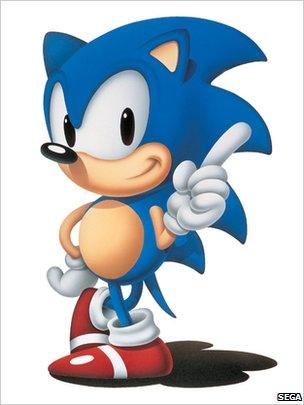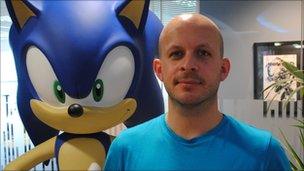Twenty years of Sonic the Hedgehog
- Published
Sonic brand director David Corless looks back at the hedgehog's history
For an entire generation of gamers, this is where it all started. Spinning into life in 1991, Sega's spiky blue mascot took the gaming world by storm. But as he celebrates his 20th birthday, what's next for Sonic the Hedgehog?
At the start of the '90s, Sega had a problem - a big, fat, moustachioed Italian plumber problem.
Although it had just launched the well-received Megadrive console (Genesis in the US), the company was still no match for the might of Nintendo, with its NES games machine and rotund plumber hero, Mario.
During its first full year on sale, the Megadrive sold fewer units than the NES, despite Nintendo's console being over five years old.
The popularity of Mario had helped Nintendo claim 92% of the home video game market.
If Sega was to survive, something drastic had to be done.
The company's new boss, Tom Kalinske set about creating a megastar.
He tasked Sega's designers with inventing a mascot; a hero to take over from the moderately popular, but distinctly ordinary, Alex Kidd.
It took several goes - an armadillo, a rabbit and a dog were all considered - before the team settled on Sonic, a speedy blue hedgehog.
"The speed of Sonic was always a big part of the design," said David Corless, brand director for Sonic outside of Japan.
"It was born out of one of the original team members - Yuji Naka - the first programmer of Sonic.
"He had a love of all things fast, so Sonic was always going to be a quick character and that was also born out of looking at other platform games like Mario and wanting to create something that was much quicker."

Sega's now-famous mascot was almost an armadillo, rabbit or dog
Much to the annoyance of the Sonic Team, Mr Kalinske - who was a former head of toy company Mattel - toned down some rather bizarre additions to the character, most notably a human girlfriend named Madonna, and a pair of menacing fangs.
Even more controversially, Mr Kalinske decided to make Sonic the new 'pack-in' game - the title that came free in the box with every purchase of the Sega console, which itself was to be drastically lowered in price.
On 23 June, 1991, the first Sonic game hit the shelves.
As video game historian Steven L Kent recalls, it changed perceptions of Sega.
"Sonic comes out, he's got a lot of attitude. For example, if you don't keep playing, he'll stare into the camera and start tapping his foot.
"It communicated the whole attitude that Sega was not interested in being your little brother's video game console. They wanted to be the cool console."
It worked. Sonic the Hedgehog reportedly sold in excess of 15 million copies, swinging the games market 65% into Sega's favour.
Such was the character's popularity that, according to one study, he was more recognisable to US children than Mickey Mouse or Abraham Lincoln.
Naturally, a slew of sequels followed. Sonic 2 was released in November 1992, Sonic 3 in 1994.
Like Mario, he soon developed a cast of supporting characters, including a two-tailed fox companion named Tails and a love-interest called Amy.
Sonic's rise continued, with gaming spin-offs and TV shows - an approach that would eventually devalue the brand, according to Steven Kent.
"They totally diluted their message, and they diluted Sonic too. All of a sudden Sonic wasn't just running and attitude, pretty soon you had all these puzzle games and RPG games."
By 1996, Sonic had gone three dimensional. Sonic 3D Blast was released on both the Megadrive and Sega's newer machine, the Saturn. However, the game sold poorly, partly due to the dominance of the new console in town: the Sony PlayStation.
Meanwhile, old adversary Mario went from strength to strength. Mario 64, also released in 1996, was widely regarded as a milestone in gaming, and every bit as important as Sonic's debut in 1991.
Then in 1998, Sonic was propelled back into favour again with the arrival of Sega's latest console, the Dreamcast.
The first sixth-generation games machine, Dreamcast beat PlayStation 2, Nintendo Gamecube and Microsoft's Xbox to market.
With it came Sonic Adventure, the best Sonic game of recent times, according to Steven L Kent.
"It's still at that incredible speed and with 3D graphics, and it was brilliant. It was a fabulous game," he said.
But despite the head start, Dreamcast lost the console war and its demise spelled the end of Sega as a hardware manufacturer. From now on, Sonic would only appear on other companies' machines - including Nintendo's.

The new Sonic game is partly an homage to the Sonic of old, according to Sega's David Corless
The cold war truly came to an end in 2007 with the release of Mario and Sonic at the Olympic Games.
The following years brought a few more Sonic titles, but the glory days had clearly passed.
To mark the 20th anniversary, Sega is releasing Sonic Generations, a combination of modern Sonic - with its 3D style - and classic Sonic.
Steven L Kent holds on to the hope that a single great Sonic game would be enough to make the character popular again.
"One more Sonic Adventure and Sonic could be back up on top, he really could. But he's not there right now.
"Right now, he's Kevin Costner."